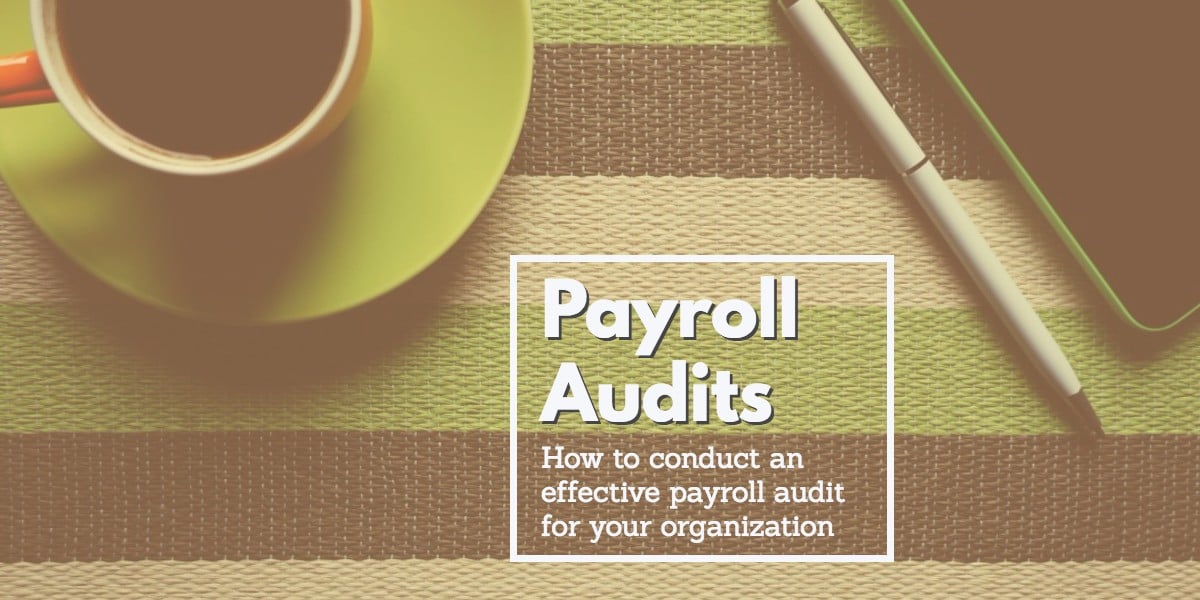.jpg?width=1200&name=payroll%20audit%20(1).jpg)
An essential part of effective payroll management is periodically auditing your payroll policies and practices. Follow these critical steps to conduct a successful payroll audit and keep your payroll practices in top shape.
What Is a Payroll Audit?
A payroll audit is a deliberate process you can undertake to review your payroll processes and records. The ultimate goal of an audit is to deliver higher payroll accuracy to your employees and to ensure your payroll processes are fully in compliance with regulations.
Ideally, you should conduct a payroll audit on a routine basis or any time there are notable changes in your organization or its internal processes. For example, it is a good idea to conduct a payroll audit if your organization has had a merger, restructured, or changed in the size and scope of the workforce.
Why Should You Conduct a Payroll Audit?
Payroll accuracy is often the most critical reason to conduct a payroll audit. According to a recent Deloitte study, payroll accuracy is one of the top three payroll concerns of payroll professionals. To address this concern, 81 percent said that they conduct periodic reviews of their payroll processes.
Whether you conduct the audit yourself or with the help of a third party, regularly reviewing your payroll activities can help you:
- Maintain accuracy and compliance.
- Identify and correct errors.
- Keep payroll records organized.
- Strengthen your financial controls.
How to Conduct an Effective Payroll Audit
Following a clear process when conducting your payroll audit can help you make sure you’re covering all the bases and identifying opportunities for improvement. Be sure to include the following steps when conducting your next payroll audit:
Verify pay rates
It may seem unnecessary to check employee pay rates in the payroll system, but given all the changes that occur in an employee’s pay over time, this is a good place to start.
As employees receive promotions or shift to different schedules or positions, their pay rate can change. By verifying pay rates, you can be sure to catch any overpayments or underpayments before they become a long-term problem.
Compare Pay Rates to Time and Attendance Records
An employee’s Fair Labor Standards Act (FLSA) classification status impacts their eligibility for overtime, so your audit should include a check of whether employees are properly classified as FLSA exempt or non-exempt. Similarly, you’ll also want to check if employees who have changed positions have also had changes in their overtime pay eligibility.
As employees change jobs over time, they may shift between full-time and part-time hours. Therefore, to stay in compliance with Affordable Care Act (ACA) requirements, you’ll need to make sure you know which employees are considered full-time and eligible for benefits.
You should also make sure there haven’t been any overpayments or underpayments to employees out on sick leave, vacation, or extended leave. For example, if an employee’s pay didn’t resume upon return to work from unpaid leave, you’ll need to make a correction and provide the missed payments.
Confirm Pay for Active Employees
At this stage of your payroll audit, you will need to verify that everyone who received a paycheck for the prior pay periods actually worked during those pay periods. An audit not only uncovers instances in which employees may have been paid for time they didn’t work, but can also help you identify controls to prevent that from happening again.
Using a payroll system that integrates with your HR systems can help you confirm that terminated employees have been removed from payroll and your benefits plans. Having this capability can help you avoid paying salaries and benefits premiums for employees who have moved on to another employer.
Check Independent Contractor and Vendor Statuses
Though independent contractors aren’t on your employee payroll, they are a part of your contingent workforce and their pay should be included in your audit. You should make sure all contractors are correctly classified and aren’t actually considered employees, as issues with classification can create complications with the U.S. Department of Labor. In addition, you want to make sure all payments to contractors match the work performed at the agreed upon rate.
Cross-Check Payroll Reports to the General Ledger
Payroll reports shouldn’t be reviewed in a vacuum. At this stage of your audit, check that the totals from your gross payroll expenses, withheld taxes, and net check amounts all match the general ledger records. You’ll also need to take an extra look at any large or unusual amounts to make sure they don’t signal an error.
Validate Bank Reconciliation for the Payroll Account
The payments in your payroll register should match the payments in your bank statements. Make a note of any discrepancies in dates or amounts, and investigate to ensure you know the cause.
Review Payroll Tax Submissions
Monthly and quarterly payroll taxes frequently change due to changes in the law or shifts in employee gross pay. Make sure your audit includes a review of payroll taxes so you can identify potential issues, such as incorrect Social Security, federal, or state unemployment tax payments.
Maintain a Healthy Payroll Management Process
Managing payroll requires keeping your attention on various deadlines and compliance requirements while also tracking changes and deductions in employee pay. By taking the time to periodically audit your payroll activities, you can not only identify and correct errors, but you can also find opportunities for improvement and automation. For more tips to help you manage payroll more efficiently, read our Guide to Saving Time on Payroll.
Originally published May 23, 2017, updated April 27, 2021.


